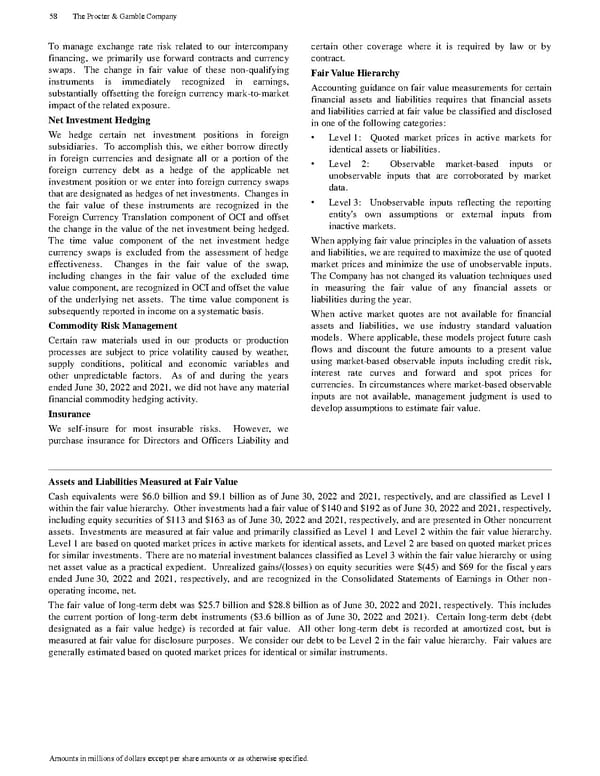To manage exchange rate risk related to our intercompany financi ng, we primarily use forward contracts and currency swaps. The change in fair value of these non - qualifying instruments is immediately recognized in earnings, substantially offsetting the foreign currency mark - to - market impact of the related exposure. N et Investment Hedging We hedge certain net investment positions in foreign subsidiaries. To accomplish this, we either borrow directly in foreign currencies and designate all or a portion of the foreign currency debt as a hedge of the applicable net inves tment position or we enter into foreign currency swaps that are designated as hedges of net investments. Changes in the fair value of these instruments are recognized in the Foreign Currency Translation component of OCI and offset the change in the value of the net investment being hedged. The time value component of the net investment hedge currency swaps is excluded from the assessment of hedge effectiveness. Changes in the fair value of the swap, including changes in the fair value of the excluded tim e value component, are recognized in OCI and offset the value of the underlying net assets. The time value component is subsequently reported in income on a systematic basis. Commodity Risk Management Certain raw materials used in our products or product ion processes are subject to price volatility caused by weather, supply conditions, political and economic variables and other unpredictable factors. As of and during the years ended June 30, 2022 and 2021, we did not have any material financial commodity hedging activity. Insurance We self - insure for most insurable risks. However, we purchase insurance for Directors and Officers Liability and certain other coverage where it is required by law or by contract. Fair Value Hierarchy Accounting guidance on fa ir value measurements for certain financial assets and liabilities requires that financial assets and liabilities carried at fair value be classified and disclosed in one of the following categories: • Level 1: Quoted market prices in active markets for ide ntical assets or liabilities. • Level 2: Observable market - based inputs or unobservable inputs that are corroborated by market data. • Level 3: Unobservable inputs reflecting the reporting entity's own assumptions or external inputs from inactive markets. Wh en applying fair value principles in the valuation of assets and liabilities, we are required to maximize the use of quoted market prices and minimize the use of unobservable inputs. The Company has not changed its valuation techniques used in measuring t he fair value of any financial assets or liabilities during the year. When active market quotes are not available for financial assets and liabilities, we use industry standard valuation models. Where applicable, these models project future cash flows an d discount the future amounts to a present value using market - based observable inputs including credit risk, interest rate curves and forward and spot prices for currencies. In circumstances where market - based observable inputs are not available, manageme nt judgment is used to develop assumptions to estimate fair value. Assets and Liabilities Measured at Fair Value Cash equivalents were $6.0 billion and $9.1 billion as of June 30, 2022 and 2021, respectively, and are classified as Level 1 within the fair value hierarchy. Other investments had a fair value of $140 and $192 as of June 30, 2022 and 2021, respectively, including equity securities of $113 and $163 as of June 30, 2022 and 2021, respectively, and are presented in Other noncurrent assets. Investments are measured at fair value and primarily classified as Level 1 and Level 2 within the fair value hierarc hy. Level 1 are based on quoted market prices in active markets for identical assets, and Level 2 are based on quoted market pric es for similar investments. There are no material investment balances classified as Level 3 within the fair value hierarchy or us ing net asset value as a practical expedient. Unrealized gains/(losses) on equity securities were $(45) and $69 for the fiscal y ears ended June 30, 2022 and 2021, respectively, and are recognized in the Consolidated Statements of Earnings in Other non - ope rating income, net. The fair value of long - term debt was $25.7 billion and $28.8 billion as of June 30, 2022 and 2021, respectively. This includes the current portion of long - term debt instruments ($3.6 billion as of June 30, 2022 and 2021). Certain lo ng - term debt (debt designated as a fair value hedge) is recorded at fair value. All other long - term debt is recorded at amortized cost, but is measured at fair value for disclosure purposes. We consider our debt to be Level 2 in the fair value hierarchy. Fair values are generally estimated based on quoted market prices for identical or similar instruments. 58 The Procter & Gamble Company Amounts in millions of dollars except per share amounts or as otherwise specified.
 The Procter & Gamble Annual Report Page 69 Page 71
The Procter & Gamble Annual Report Page 69 Page 71